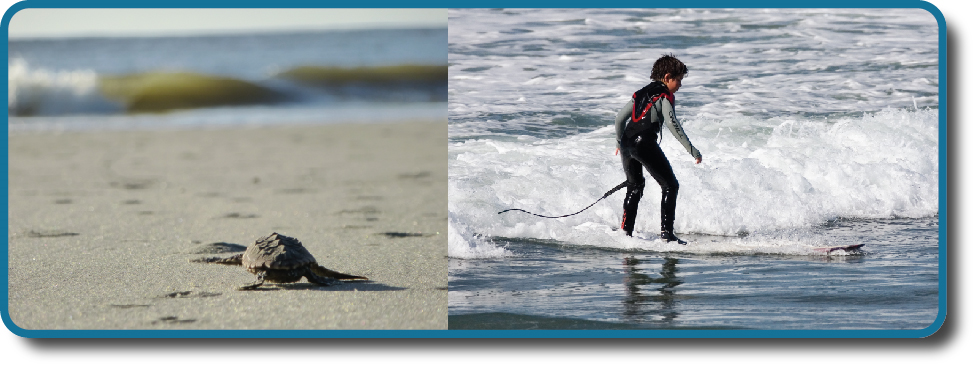6.1: 学习前奏
- Page ID
- 203546
学习目标
- 研究学习的主要方式
夏日的阳光明媚地照在荒凉的海滩上。 突然间,一个灰色的小头从沙子里冒出来,然后又一个又一个。 很快,海滩上到处都是黑头海龟幼体(图)。 尽管只有几分钟大,但幼体确切地知道该怎么做。 他们的脚鳍在炎热的沙滩上移动的效率不是很高,但它们本能地继续前进。 有些很快就被头顶盘旋的海鸥抢购一空,而另一些则变成了午餐,让饥饿的幽灵蟹从洞里飞出来。 尽管存在这些危险,但幼体还是被迫离开安全的巢穴去寻找海洋。

在同一个海滩不远处,本和他的儿子朱利安在冲浪板上划船进入大海。 一波浪潮临近。 朱利安蹲在棋盘上,然后跳起来,在海浪中骑几秒钟,然后失去平衡。 他及时从水里出来,看着他的父亲在海浪中乘风破浪。
与小海龟不同,他们知道如何在没有父母帮助的情况下寻找大海和游泳,我们不是天生就知道如何游泳(或冲浪)。 然而,我们人类为自己的学习能力感到自豪。 事实上,几千年来,跨文化,我们创建了完全致力于学习的机构。 但是你有没有问过自己我们到底学到了什么? 当我们了解我们所知道的东西时,哪些流程在起作用? 本章重点介绍学习的主要方式。
References
Anderson, C. A., & Gentile, D. A. (2008). Media violence, aggression, and public policy. In E. Borgida & S. Fiske (Eds.), Beyond common sense: Psychological science in the courtroom (p. 322). Malden, MA: Blackwell.
Bandura, A., Ross, D., & Ross, S. A. (1961). Transmission of aggression through imitation of aggressive models. Journal of Abnormal and Social Psychology, 63, 575–582.
Cangi, K., & Daly, M. (2013). The effects of token economies on the occurrence of appropriate and inappropriate behaviors by children with autism in a social skills setting. West Chester University: Journal of Undergraduate Research. Retrieved from www.wcupa.edu/UndergraduateRe...angi_S2012.pdf
Carlson, L., Holscher, C., Shipley, T., & Conroy Dalton, R. (2010). Getting lost in buildings. Current Directions in Psychological Science, 19(5), 284–289.
Cialdini, R. B. (2008). Influence: Science and practice (5th ed.). Boston, MA: Pearson Education.
Chance, P. (2009). Learning and behavior (6th ed.). Belmont, CA: Wadsworth, Cengage Learning.
DeAngelis, T. (2010). ‘Little Albert’ regains his identity. Monitor on Psychology, 41(1), 10.
Franzen, H. (2001, May 24). Gambling, like food and drugs, produces feelings of reward in the brain. Scientific American [online]. Retrieved from www.scientificamerican.com/ar...e-food-and-dru
Fryer, R. G., Jr. (2010, April). Financial incentives and student achievement: Evidence from randomized trials. National Bureau of Economic Research [NBER] Working Paper, No. 15898. Retrieved from http://www.nber.org/papers/w15898
Garcia, J., & Koelling, R. A. (1966). Relation of cue to consequence in avoidance learning. Psychonomic Science, 4, 123–124.
Garcia, J., & Rusiniak, K. W. (1980). What the nose learns from the mouth. In D. Müller-Schwarze & R. M. Silverstein (Eds.), Chemical signals: Vertebrates and aquatic invertebrates (pp. 141–156). New York, NY: Plenum Press.
Gershoff, E. T. (2002). Corporal punishment by parents and associated child behaviors and experiences: A meta-analytic and theoretical review. Psychological Bulletin, 128(4), 539–579. doi:10.1037//0033-2909.128.4.539
Gershoff, E.T., Grogan-Kaylor, A., Lansford, J. E., Chang, L., Zelli, A., Deater-Deckard, K., & Dodge, K. A. (2010). Parent discipline practices in an international sample: Associations with child behaviors and moderation by perceived normativeness. Child Development, 81(2), 487–502.
Hickock, G. (2010). The role of mirror neurons in speech and language processing. Brain and Language, 112, 1–2.
Holmes, S. (1993). Food avoidance in patients undergoing cancer chemotherapy. Support Care Cancer, 1(6), 326–330.
Hunt, M. (2007). The story of psychology. New York, NY: Doubleday.
Huston, A. C., Donnerstein, E., Fairchild, H., Feshbach, N. D., Katz, P. A., Murray, J. P., . . . Zuckerman, D. (1992). Big world, small screen: The role of television in American society. Lincoln, NE: University of Nebraska Press.
Hutton, J. L., Baracos, V. E., & Wismer, W. V. (2007). Chemosensory dysfunction is a primary factor in the evolution of declining nutritional status and quality of life with patients with advanced cancer. Journal of Pain Symptom Management, 33(2), 156–165.
Illinois Institute for Addiction Recovery. (n.d.). WTVP on gambling. Retrieved from http://www.addictionrecov.org/InTheNews/Gambling/
Jacobsen, P. B., Bovbjerg, D. H., Schwartz, M. D., Andrykowski, M. A., Futterman, A. D., Gilewski, T., . . . Redd, W. H. (1993). Formation of food aversions in cancer patients receiving repeated infusions of chemotherapy. Behaviour Research and Therapy, 31(8), 739–748.
Kirsch, SJ (2010). Media and youth: A developmental perspective. Malden MA: Wiley Blackwell.
Lefrançois, G. R. (2012). Theories of human learning: What the professors said (6th ed.). Belmont, CA: Wadsworth, Cengage Learning.
Miller, L. E., Grabell, A., Thomas, A., Bermann, E., & Graham-Bermann, S. A. (2012). The associations between community violence, television violence, intimate partner violence, parent-child aggression, and aggression in sibling relationships of a sample of preschoolers. Psychology of Violence, 2(2), 165–78. doi:10.1037/a0027254
Murrell, A., Christoff, K. & Henning, K. (2007) Characteristics of domestic violence offenders: associations with childhood exposure to violence. Journal of Family Violence, 22(7), 523-532.
Pavlov, I. P. (1927). Conditioned reflexes: An investigation of the physiological activity of the cerebral cortex (G. V. Anrep, Ed. & Trans.). London, UK: Oxford University Press.
Rizzolatti, G., Fadiga, L., Fogassi, L., & Gallese, V. (2002). From mirror neurons to imitation: Facts and speculations. In A. N. Meltzoff & W. Prinz (Eds.), The imitative mind: Development, evolution, and brain bases (pp. 247–66). Cambridge, United Kingdom: Cambridge University Press.
Rizzolatti, G., Fogassi, L., & Gallese, V. (2006, November). Mirrors in the mind. Scientific American [online], pp. 54–61.
Roy, A., Adinoff, B., Roehrich, L., Lamparski, D., Custer, R., Lorenz, V., . . . Linnoila, M. (1988). Pathological gambling: A psychobiological study. Archives of General Psychiatry, 45(4), 369–373. doi:10.1001/archpsyc.1988.01800280085011
Skinner, B. F. (1938). The behavior of organisms: An experimental analysis. New York, NY: Appleton-Century-Crofts.
Skinner, B. F. (1953). Science and human behavior. New York, NY: Macmillan.
Skinner, B. F. (1961). Cumulative record: A selection of papers. New York, NY: Appleton-Century-Crofts.
Skinner’s utopia: Panacea, or path to hell? (1971, September 20). Time [online]. Retrieved from http://www.wou.edu/~girodm/611/Skinner%27s_utopia.pdf
Skolin, I., Wahlin, Y. B., Broman, D. A., Hursti, U-K. K., Larsson, M. V., & Hernell, O. (2006). Altered food intake and taste perception in children with cancer after start of chemotherapy: Perspectives of children, parents and nurses. Supportive Care in Cancer, 14, 369–78.
Thorndike, E. L. (1911). Animal intelligence: An experimental study of the associative processes in animals. Psychological Monographs, 8.
Tolman, E. C., & Honzik, C. H. (1930). Degrees of hunger, reward, and non-reward, and maze performance in rats. University of California Publications in Psychology, 4, 241–256.
Tolman, E. C., Ritchie, B. F., & Kalish, D. (1946). Studies in spatial learning: II. Place learning versus response learning. Journal of Experimental Psychology, 36, 221–229. doi:10.1037/h0060262
Watson, J. B. & Rayner, R. (1920). Conditioned emotional reactions. Journal of Experimental Psychology, 3, 1–14.
Watson, J. B. (1919). Psychology from the standpoint of a behaviorist. Philadelphia, PA: J. B. Lippincott.
Yamamoto, S., Humle, T., & Tanaka, M. (2013). Basis for cumulative cultural evolution in chimpanzees: Social learning of a more efficient tool-use technique. PLoS ONE, 8(1): e55768. doi:10.1371/journal.pone.0055768


